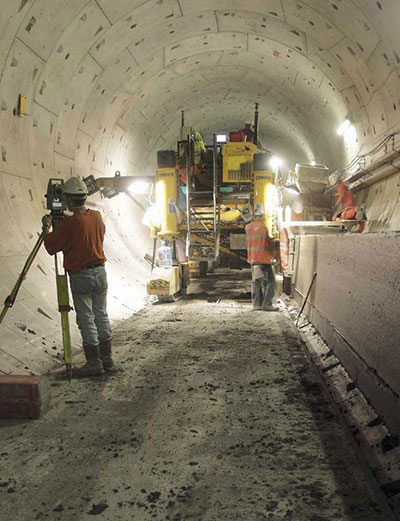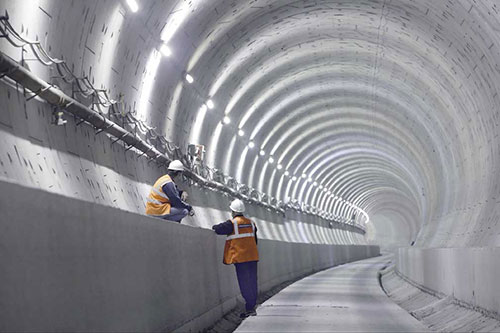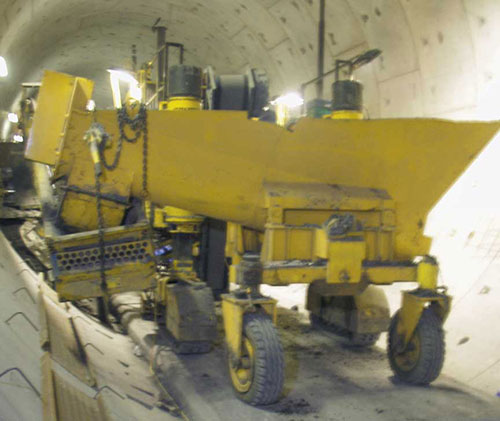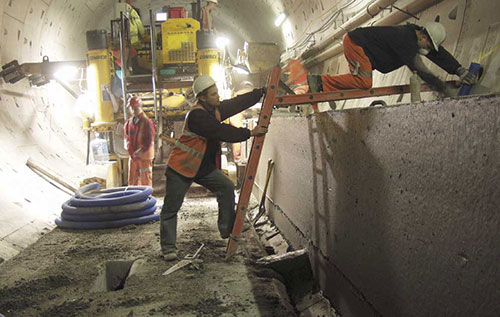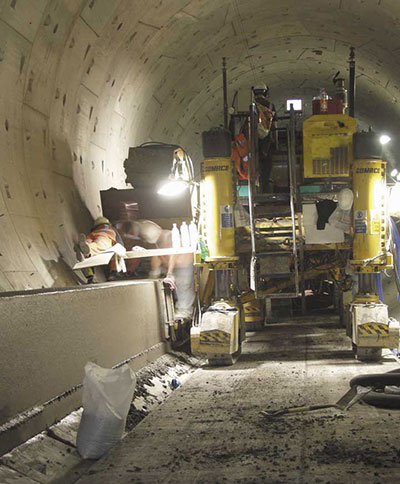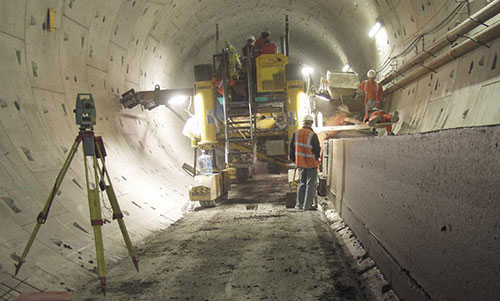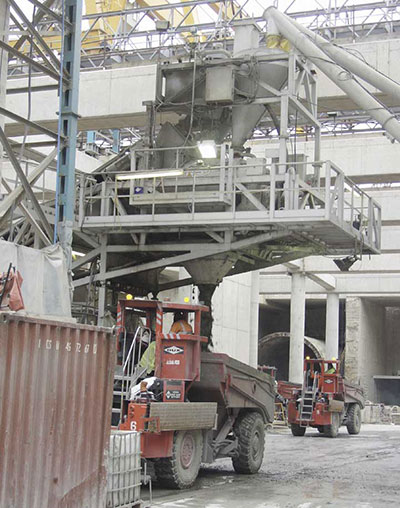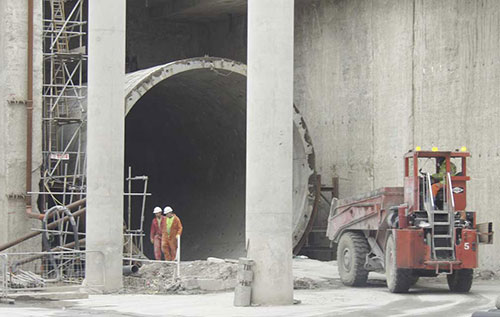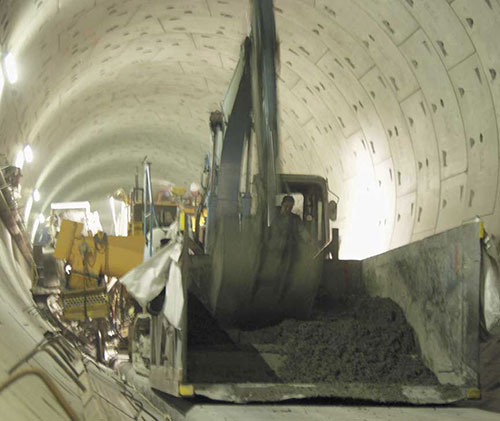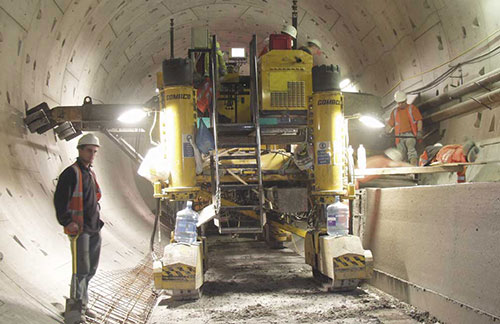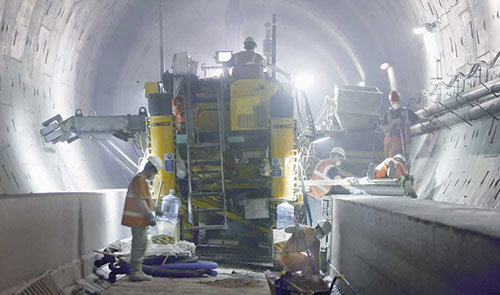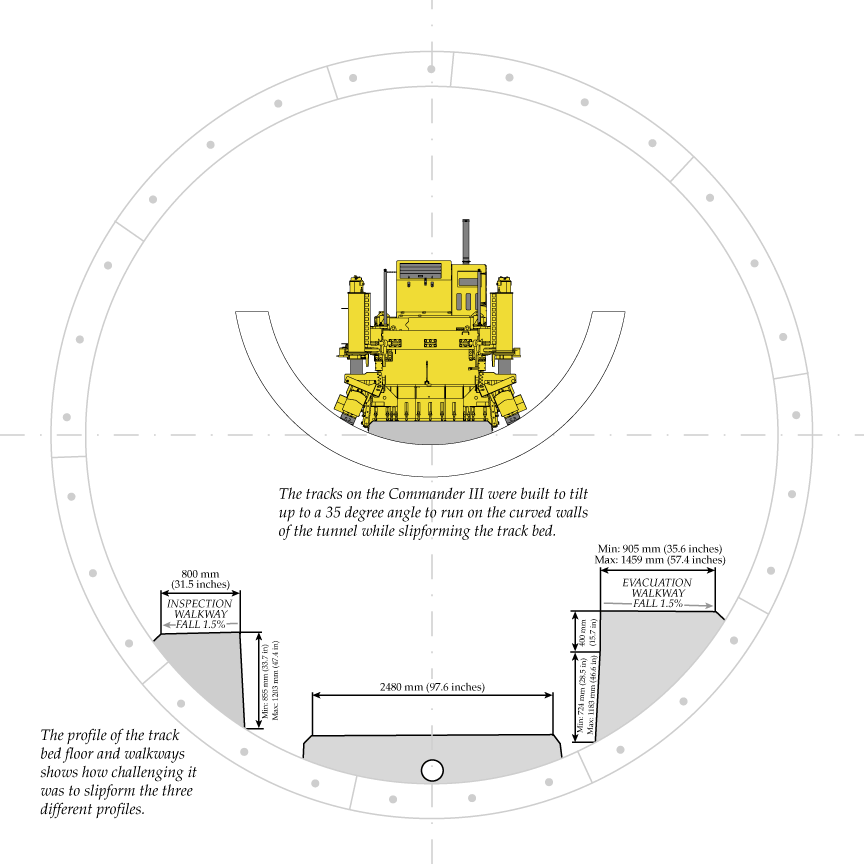GOMACO World Index --- GOMACO World 33.1 - February 2005
At Work 24/7 On The Channel Tunnel Rail Link Project
Stratford Box near London, England, is a hub of activity. Workers climb up and down several flights of stairs to and from work. A concrete batch plant is at work and Dux trucks regularly appear out of the tunnel to be re-loaded with concrete. The drivers take their load to one of the two tunnel openings that comprise the Channel Tunnel Rail Link (CTRL) Contract 220.
Contract 220 is part of the massive Channel Tunnel Rail Link Project that connects the center of London to the Channel Tunnel and Europe. There are three major tunnel contracts to take the new high-speed line under east London, C220 is the largest. All three contracts used GOMACO equipment to place the tunnel trackbed and walkways. In total, there are approximately 22 miles (35.4 km) of tunnel requiring 65 miles (105 km) of slipform paving.
The two new tunnels are being built by the Nishimatsu-Cementation Skanska Joint Venture for project manager Rail Link Engineering (led by Bechtel) and client Union Railways. Work on Contract 220 began three years ago with the boring out and building of two 4.7 mile (7.5 km) tunnels with a 23.5 feet (7.15 m) internal diameter. They’re currently in the final phases, slipforming the concrete track bed, an evacuation walkway and a maintenance walkway.
“We liked the idea of slipforming because it would be quick and would drastically reduce the number of men needed for the operation,” Bill Brundan, tunnel agent for the Nishimatsu-Cementation Skanska Joint Venture responsible for building the new railway tunnels at Contract 220, explained. "But we needed to find someone with the expertise to help carry out the work. GOMACO introduced to us Peter Davidson and Peter was involved from a very early stage and jointly we chose the subsidiary plant and equipment and ironed out all the methods. Peter Davidson has certainly been a vital part of the paving operation.”
But would the concrete walkways stick and stay standing on the circular walls of the tunnel? Members of the joint venture were skeptical. Plus, they had limited experience slipforming concrete and working with slipform pavers. They decided early on to have Peter Davidson and his Commander III carry out trials to see if they could slipform the project.
“Before we decided to go paving, we did a number of trials,” Brundan explained. “We actually built dummy tunnels on the surface where we erected some segments to imitate the tunnel and we used a Commander III to do extensive trials to see if it was possible. We tested the reinforcement, the dowels, the ways of actually getting the concrete to stick to the wall.
“We wouldn’t make the decision to pave until we’d confirmed in our minds that it was physically possible. The trials clearly showed that it would work.”
Peter Davidson and his crew were given the go-ahead to slipform the three different applications.
“You learn early on that you have to be very patient when working on a tunnel project," Davidson said. "When we started this project, we had no tunnel experience, but we’re very good at logistics, road paving, batch plants and production.
Four of the tunnels and the bulk of the equipment, batching plant, and tunnel openings are in the Stratford Box, an area that will one day be the new Stratford Station for the high-speed passenger rail line that will travel through Contract 220’s two new tunnels.
Distances inside of the tunnel are measured differently from other projects. A tunnel’s unit of measurement is called a ring.
“The rings are numbered as we build them with the tunnel boring machines,” Brundan said. “It’s easy for us to count rings rather than measure our chainage and distance.
“The tunnel is made up of precast concrete segments and each ring of segments is ten sections. Each piece is 3.0 tons and one ring of ten segments is nearly 30 tons. They’re 4.9 feet (1.5 m) long and there’s about 5,020 rings in each of our tunnels giving us a length of about 4.7 miles (7.5 km).”
The Commander III, and all of the equipment in the tunnel, is running on the new track bed, the first of the three slipformed phases in each tunnel.
“The track bed’s running surface is about 8.2 feet (2.5 m) wide,” Brundan said. “It was laid in a circular tunnel so in the center of the tunnel it’s about 23.6 inches (600 mm) deep.”
The tracks on the Commander III were built to tilt up to a 35 degree angle to accommodate the curvature of the tunnel. Another challenge in paving the tunnel’s track bed included slipforming over a 9.8 inch (250 mm) diameter ducting pipe.
“We laid the pipe just in front of the paver and connected everything up as we went,” John Crouch, Davidson’s foreman, said. “There has been some 2500 lengths of ducting and we managed to come up with simple methods to allow the ducts to be put in without stopping or delaying the paving process.”
“We decided in the early days that the only way to take this contract on was to do everything,” Davidson said. “If we had other people fixing pipes or steel for us, they’d just hold us up. We connect all the pipes and services as we go so there’s no extra finishing work, no jack hammering or cleaning out of anything.”
During one stretch of slipforming the track bed, the Commander III ran 10.5 days straight, 24 hours a day without stopping. During that time, Peter Davidson’s crew laid down 4.7 miles (7.5 km) of track bed covering the entire length of one tunnel.
Phase One of the C220’s CTRL’s concrete slipforming project was complete. The next phase involved slipforming two different types of walkway, an evacuation and a maintenance walkway. The evacuation walkway is designed in case of an emergency. If the passengers need to evacuate the train, they simply have to step out of the train onto the walkway and follow it out of the tunnel.
“The walkways are more challenging because the horizontal surface and the vertical surface are varying all the time depending on the tunnel alignment or tunnel cant,” Brundan explained. “That means that the walkway can go from a 4.9 feet (1.5 m) width on the top surface down to about a 3.6 feet (1.1 m) width. It varies all the time.”
The mold is hydraulic and capable of expanding or contracting up to 20 inches (500 mm) on both its top plate and sideplate. It was tricky at first, getting the walkway to follow the curving tunnel profile while maintaining line and level. The outside line of the finished wall will only be two inches (50 mm) away from the high-speed train that will soon be running in the tunnel.
“The walkway at its largest was 5.2 feet (1.6 m) high and 4.9 feet (1.5 m) wide and that’s a fair block of concrete that attempts to push that paving machine off the wall,” Davidson explained.
“We have a hydraulic jack system with wheels that come from the body of the paver to the opposite wall of the walkway we’re paving,” Brundan continued. “With the considerable variation of the tunnel alignment and the cant, the wall goes all over the place. There’s really no straight lines in that tunnel and our system helps to make everything stable and keeps the walls standing upright.”
Ductwork and piping also have to be dealt with in the walkways, just like the track bed. Finishing work on those is carried out directly behind the paver. Nothing is left behind for completion at a later date.
Concrete is delivered to the paver by Dux trucks that carry 8 yd3 (6.1 m3) and everything that goes into the tunnel is in a preset sequence. Two crossing bridges or ramps are strategically placed at certain points to allow the trucks to pass. The top of each ramp is located 27.6 inches (700 mm) off the floor to allow enough width for two trucks to pass each other inside the tunnel. Drivers quickly learn the passing rule.
“Each truck goes in and stops at the first ramp, waiting for an empty truck to come from the other direction,” Brundan said. “Once an empty truck passes you on a ramp, you can proceed. If an empty truck doesn’t come out, you can’t go on. Drivers pick that up pretty quick.”
The Dux were chosen early on in the project planning phase because of their shape and hauling capacity. The Dux drivers as quickly as possible dump their load of concrete into a large skid. A 13-ton excavator, with a shortened boom to work in the tight tunnel conditions, scoops the concrete out of the skid and dumps it into the hopper in front of the Commander III.
The maintenance walkway itself is 31.5 inches (800 mm) wide and 47.4 inches (1203 mm) tall. Its high production was exceeding everyone’s expectations.
“We’ve gotten up to 1969 feet (600 m) in a 12-hour shift on the smaller wall," Crouch said. "It’s getting faster all the time because we’re coming out of the tunnel. All of the records are getting broken. I’m sure they’ll reach 3937 feet (1200 m) in a 24-hour shift.”
The walkway is poured in 9843 feet (3000 m) sections with a 4921 feet (1500 m) stagger in between. The walkway has to be slipformed in these shorter segments to accommodate the ramps and concrete delivery. Once one walkway is in place, there’s no room to place the crossing ramps.
Finishing work behind the paver is kept to a minimum. No joints or curing compound are required because the tunnel is the perfect drying environment for concrete. It maintains a steady temperature and a dry environment.
“Production has been fantastic,” Brundan said. “We’re putting down a phenomenal amount of concrete in a 24-hour period. If we had gone the traditional hand-forming method, we would have gotten outputs of approximately 164 to 328 feet (50 to 100 m) per day, at best. There’s really no comparison. The time we’ve saved and also the manpower we’ve saved has been considerable.”
Another time savings on the project has been the use of the Leica stringless guidance system instead of traditional stringline. Tunnel conditions just weren’t favorable for stringline use, plus the manpower needed to set up the line would have been considerable.
“We couldn’t use stringline because we wouldn’t have had enough surveyors to set it and get it all ready in time,” Brundan said. “We used a 3-D system when we were boring the tunnels and it was a natural step to use a stringless 3-D system on the paver. Leica is a very good system and I don’t think we could have done it any other way.”
Sitting just outside the two tunnel entrances is Davidson’s twin-shaft mixer, Compactor batch plant. It has a capacity to produce up to 157 yd3 (120 m3) of concrete per hour.
“It mixes the dry concrete that a lot of other plants would have struggled with,” Brundan said. “It’s a plant that has plenty of capacity and it gives us high outputs and high production."
The mix design itself is a very dry design with both 0.4 and 0.8 inch (10 and 20 mm) sized limestone, two types of sand, a super-plasticizer and an air-entrainment agent.
“It’s a very dry concrete and very hard to handle,” Brundan said. “You couldn’t handle it by hand or with shovels, but the Commander III is obviously ideal for it.”
“The machinery that we selected for this project has all been unbelievable,” Davidson said. “The Commander III has run the last six months, seven days a week, 24 hours per day. It just keeps going and going and going. The production we’re getting right now is just out of this world.”
The tunnel work that, despite its challenges, Davidson and his crew are ready to take on again.
“We’d go anywhere in the world to work on another tunnel,” Crouch said without hesitation. “It’s interesting work, you can plan your jobs and you don’t have to worry about the weather. Once you’re set up, you just go.”
They slipformed their last bit of wall on October 22, 2004, finishing their part of the CTRL contract two months ahead of schedule. In less than six months, Davidson and his crew have slipformed almost 47 miles (75 km) of tunnel rail bed and walkways.
Editor’s Note: Randy Bach, GOMACO’s Advertising Manager, and I had the privilege of traveling across the Atlantic Ocean and visiting CTRL’s job site in person. It was our first time inside a tunnel still under construction and it was an amazing experience. Thank you to everyone at CTRL, Peter Davidson and GOMACO International Ltd. for making this trip possible. – Kelly Krueger, GOMACO World Editor
Subscribe to Receive GOMACO World Magazine
